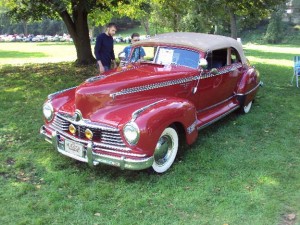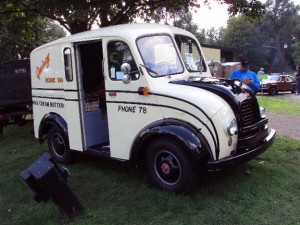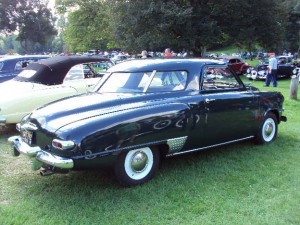Jack Miller is a persistent man. You would expect that of a man who claims to be “the world’s last Hudson dealer.” For those who don’t recognize the name – brought back by the character Paul Newman voiced in the original animated Pixar film, Cars – Hudson was a once popular automotive brand that vanished in 1954, subsumed by the forever-struggling American Motors.
Miller’s showroom sits in a back corner of Ypsilanti, itself a backwoods suburb of Detroit. But it has become the anchor of an annual pilgrimage by some of the world’s most serious car-nuts, folks who don’t really concede that brands like Hudson or DeSoto, Packard or Plymouth are gone. And they’re not during the yearly Orphan Car Show Miller inaugurated in 1997 — just before several of the latest brands, including Oldsmobile and Plymouth, headed for that rust heap in the sky.
It is said that “Beauty is in the eye of the beholder,” and for my money there is nothing more appealing than this offbeat gathering, held this year on the last Sunday in September.
This show isn’t the stuff of Social Register types who spend hundreds of thousands of dollars – sometimes millions — acquiring rare classics from the likes of Bugatti or Talbot Lago and then investing still more big bucks having them restored to flawless perfection for display at a Concours d’Elegance like the ones in Pebble Beach and Amelia Island.
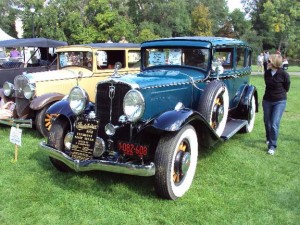
Studebaker had a strange way with names, chosing to pair the President (r) with the pre-war Dictator.
Nor is Ypsi the stuff of Rod & Custom and Muscle Car shows for shadetree mechanics, pretty much at the other end of the car show spectrum.
Ypsi is for lovers of the forgotten brands of yesteryear. To appreciate this idea fully, let us consider snapshots of the top sales leaders from historic auto sales years.
Although the stock market crash triggering the Great Depression took place late in 1929, it took a while for the full effect to be felt. The low point in employment and auto sales was 1932. So 1929 was still the domestic auto industry’s best year to that point in time, with new car registrations of 4.015 million. The top ten sellers were, in order, Ford at 1.356,000, Chevrolet 807,300, Hudson Essex 198,000, Willys-Overland Whippet 168,000, Pontiac 163,800, Buick 162,300, Dodge 119,800, Nash 108,000, Oldsmobile 92,600 and the new-to-the-market Plymouth 87,900.
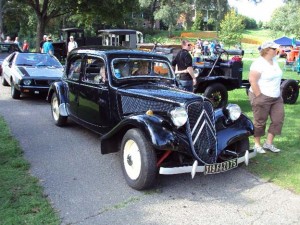
The Orphan Car Show is anything but xenophobic, welcoming products from abroad built by makers no longer operating in the U.S., such as Citroen.
According to one historical analysis America has seen more than 800 names come — and largely go — since the Duryea Brothers launched what is generally accepted as the country’s first true car company, in 1896. Many of them didn’t make it into the 20th Century. And we have seen a fair number vanish in recent years, including the likes of Saturn, Mercury, Hummer and the once formidable Pontiac.
The Depression killed off a lot of brands, especially medium- or high-priced but low-volume cars such as Auburn, Bantam, Cord, De Vaux, Durant, Duesenberg, Franklin, Gardner, Hupmobile, Jordan, Marmon, Pierce-Arrow, Reo, Rockne, and Willys-Knight.
By 1937, the industry’s first recovery year with 3,483.8 million new registrations, the top ten list had changed, mainly with Chrysler Corporation’s ascent: Chevrolet 768,040, Ford 765,933, Plymouth 462,268, Dodge 255,258, Pontiac 212,403, Buick 205,297, Oldsmobile 188,306, Packard 95,455, Chrysler 91,622, and Hudson 90,043.
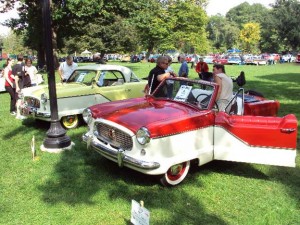
Nash, later a part of American Motors, tried desperately to sell Americans on the virtues of small cars like these Metropolitans.
The last U.S. peacetime year, 1941, saw total new car registrations of 3.731.2. The top ten sellers were Chevrolet 880,346, Ford 602,031, Plymouth 452,187, Buick 308,615, Pontiac 286,123, Oldsmobile 230,367, Dodge 215,563, Chrysler 143,025, Studebaker 114,331, and DeSoto 91,004.
The best immediate post-World War II year, when all makers had their new models out and before Korean War production constraints hit—though Chrysler was crippled by a long UAW strike for pensions—was 1950, when industry new registrations came to 6.326.4 million. Chevrolet led with 1,420,399, followed by Ford at 1,166,118, Plymouth 547,367, Buick 535,807, Pontiac 440,526, Oldsmobile 372,519, Mercury 318, 217, Dodge 300,104, Studebaker 268,229 and Nash 175,722.
Note how many “top tens” in significant years past are now Orphans, no longer being built, the most recent being Mercury.
And these are the automotive stuff from which the Orphan Car Show attracts. However, to prevent clawbacks, only makes orphaned for at least seven years are allowed. Thus Oldsmobile, killed off in 2004 by GM, was admitted for the first time this year.
In addition, Orphan Car meister Miller otherwise permits only domestics built through the 1963 model year. For one thing, product proliferation and branding had hit the domestic industry by then and things got complicated. There was no longer just one Chevrolet, for instance: now the brand embraced “big” Chevrolet, Corvette, Corvair, Chevy II with mid-sized Chevelle just around the corner. Whatever, Jack makes the rules and the crowd doesn’t complain.
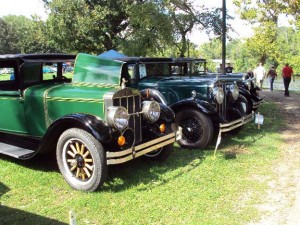
Some of the cars on display at the Orphan show were the sources of significant technical breakthroughs, such as these air-cooled Franklins.
The Orphan’s venue had long been Ypsilanti’s picturesque little Riverside Park on the Huron River just west of Depot Town. Last year, the June date not only got rained out—a risk for all car shows–but the river flooded the grounds, so the show moved this year to the end of September with weather fingers crossed.
Now to the cars. This old timer found so many fond memories that it’s hard to spotlight only a few. My first sighting, walking from the parking lot, was three vintage fire engines, um, demonstrating their power squirting streams back into the river. Yes the show includes trucks as well as cars. A highlight of the commercial class for me was a Divco dairy-delivery unit complete with faux milk in the carriers once used by every neighborhood’s milkmen.
Among the cars, Studebaker, Hudson and Kaiser were notably well represented. I saw only a couple of Plymouths and no Oldsmobiles but couldn’t catch every car because of the size of the show and the constant parade before the reviewing stand, narrated knowledgeably by auto historians Jeff Godshall and Jim Wagner.
“Americans” are not exclusive at the Orphan. Among the relatively rare (nowadays) non-classic imports spotted were Capri, Anglia, Citroen, Renault and a battered Lada. There was even a pedal car display for the youngest generation enjoying a fine family day in Ypsilanti.

